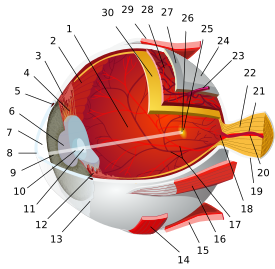| Uvea | |
|---|---|
 |
|
| Horizontal section of the eyeball. The constituents of the uvea follow: iris labeled at top, ciliary body labeled at upper right, and choroid labeled at center right.) | |
| Latin | tunica vasculosa bulbi |
| MeSH | Uvea |
- For the Pacific island, see Wallis Island.
The uvea (Lat. uva, grape), also called the uveal layer, uveal coat, uveal tract, or vascular tunic, is the pigmented middle of the three concentric layers that make up an eye. The name is possibly a reference to its reddish-blue or almost black colour, wrinkled appearance and grape-like size and shape when stripped intact from a cadaveric eye.[1] Its use as a technical term in anatomy and ophthalmology is relatively modern.
Contents |
Anatomy [link]
Regions [link]
The vascular middle layer of the eye. It is traditionally divided into 3 areas, from front to back, the iris, ciliary body, and choroid.
Physiology [link]
The prime functions of the uveal tract as a unit are:
1. nutrition and gas exchange. Uveal vessels directly perfuse the ciliary body and iris, to support their metabolic needs, and indirectly supply diffusible nutrients to the outer retina, cornea & lens, which lack any intrinsic blood supply.
2. light absorption. The uvea improves the contrast of the retinal image by reducing reflected light within the eye (analogous to the black paint inside a camera), and also absorbs outside light transmitted through the sclera, which is not fully opaque.
In addition some uveal regions have special functions of great importance, including secretion of the aqueous humour by the ciliary processes, control of accommodation (focus) by the ciliary body, and optimisation of retinal illumination by the iris's control over the pupil. Many of these functions are under the control of the autonomic nervous system.
Pharmacology [link]
The pupil provides a visible example of the neural feedback control in the body. This is subserved by a balance between the antagonistic sympathetic and parasympathetic divisions of the autonomic nervous system. Informal pharmacological experiments have been performed on the pupil for centuries, since the pupil is readily visible, and its size can be readily altered by drugs, even crude plant extracts, applied to the cornea. Pharmacological control over pupil size continues to be an important part of the treatment of some ocular diseases - see pupil, uveitis, acute glaucoma, chronic glaucoma.
The metabolically-active process of secreting aqueous humour can also be reduced by drugs, which is important in treating both acute and chronic glaucoma.
Immunology [link]
The normal uvea consists of immune competent cells, particularly lymphocytes, and is prone to respond to inflammation by developing lymphocytic infiltrates. A rare disease called sympathetic ophthalmia may represent 'cross-reaction' between the uveal and retinal antigens (i.e., the body's inability to distinguish between them, with resulting misdirected inflammatory reactions).
Pathology [link]
See uveitis, choroiditis, iritis, Iridocyclitis, anterior uveitis, sympathetic ophthalmia, uveal melanoma.
External links [link]
References [link]
- ^ eye, human."Encyclopædia Britannica from Encyclopædia Britannica 2006 Ultimate Reference Suite DVD 2009
|
|||||||||||||||||||||||||||||||||||||||||||||||||
https://wn.com/Uvea

Wallis (island)
Wallis (Wallisian: ʻUvea) is an island in the Pacific Ocean belonging to the French overseas collectivity (collectivité d'outre-mer, or COM) of Wallis and Futuna.
Geography
The island has an area of 77,5 km² and a circumference of c. 50 km. Its highest point is Mount Lulu Fakahega (131 m). There are also a handful of large lakes such as Lake Lalolalo, a sign of the island's volcanic origin, some of them almost perfect circles and with straight vertical walls, like Lalolalo, Lanu'tavake.
Uvea is located 240 km northeast of Futuna and Alofi islands. Together with some 15 smaller islands surrounding it, on its huge barrier reef, it forms the Wallis archipelago. Wallis has a fertile volcanic soil and sufficient rainfall to allow subsistence farming.
Uvea is subdivided into three districts (north to south):

Uvea (Wallis and Futuna)
ʻUvea (Wallisian: ʻUvea, French: Royaume coutumiers de Uvea) is one of the three official chiefdoms (Royaume coutumiers) of the French territory of Wallis and Futuna (the other two being Sigave and Alo) in Oceania in the South Pacific Ocean.
Geography
Overview
ʻUvea encompasses the whole of Wallis Island and the surrounding islets. The total area of the kingdom is 96 km² with a population of 10,731 spread over three districts. The capital and largest village is Matāʻutu situated on the east coast with a population of 1,100).
Administrative division
The chiefdom counts 3 districts and 21 municipalities:
History
ʻUvea has probably been inhabited by Polynesians since the 15th century CE and was then part of the Tu'i Tonga Empire. The two archaeological sites of Talietumu and Tonga Toto are remains from that period.
The kingdom of ʻUvea was founded sometimes in the 15th century and the monarch was titled Tuʻi ʻUvea (king).
April 5, 1887 the island became a French Protectorate after queen Amelia Tokagahahau Aliki signed a treaty with France but keeping her royal powers.



